- Brunswick
 Albert Street today (no schools)
Albert Street today (no schools)Blink and you might miss Randazzo Park in Albert Street, Brunswick. It’s small and unprepossessing. But at least it’s public open space – rare in the inner north – and besides, what better place to watch the cranes? Cranes on building sites that is, as the building boom ramps up nearby.
It’s peaceful in Randazzo Park, nestled between rows of townhouses. But it never used to be. Either side of you once stood Brunswick Primary School and Brunswick East High School, and lunchtimes must have been raucous affairs indeed. They were both demolished in the 1990s to make way for townhouses, on the assumption that children would never return to the area.
Brunswick East High School was merged with Brunswick High School and Brunswick Technical School to form Brunswick Secondary College. While the College is now thriving, it is located in the former technical school buildings in Dawson Street.
Brunswick Primary School was merged with Brunswick East Primary, a red-brick classic some distance away. Brunswick East Primary is also thriving, although starting to experience the over-crowding which is now typical of inner suburban schools.
There is an extra dimension to the loss of Brunswick Primary, which was one of the original Victorian schools opened in the 1870s. In 1972, the Education Department acquiesced to local requests for the Henry Bastow building to be replaced by something bigger. So, when the Kennett Government closed the school in the 1990s there were no heritage issues surrounding the bulldozing of a 1970s pre-cast concrete monstrosity supplied by the Housing Commission. Ironically, if the Bastow designed building had not been replaced it would have had heritage listing, and been converted into apartments, as occurred with South Melbourne (Dorcas Street) Primary and Yarra Park Primary.
For the record, Victoria was the first state to enact heritage legislation. In 1974. Too late for Brunswick Primary’s Bastow building. And today, visitors to Brunswick East Primary are intrigued by the presence of another school’s Great War Honour Board in its foyer.
Meanwhile, back in Randazzo Park, a commemorative plaque was unveiled in 2018. Unfortunately, it contains factual errors and confusing language. Not a great way to honour the past.
What have we learned from the past? Let’s see now:
- Ensure that fine old school buildings acquire heritage listing at the earliest opportunity.
- Revisit the heritage listing on a regular basis. While original Henry Bastow schools have been heritage listed for years, red-brick schools from the 1890s to 1920 are protected by council determined heritage overlays only. It is time for a general review.
- The memories of the lost schools should be formally acknowledged. Ideally, a consistent format will be used for all lost schools, whether they were in Albert Street, Brunswick, elsewhere in the city, or in a rural setting.
- Coburg
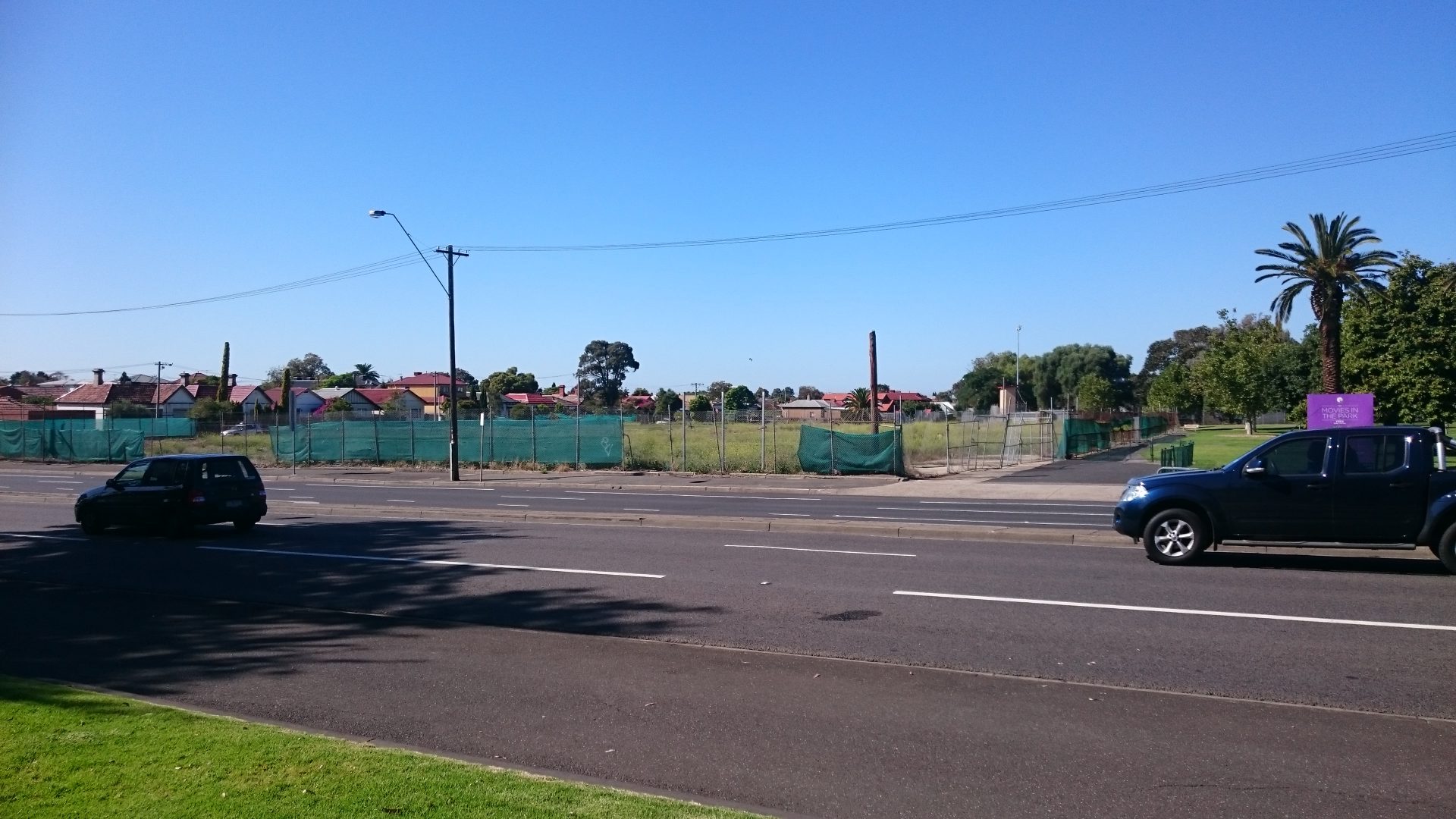 Former Coburg High School
Former Coburg High SchoolCoburg High School began life as Coburg Higher Elementary School in 1912, the first post primary school in Victoria. In 1916 it was rebadged a ‘high school’ and moved to its new building in Bell Street. During its 80 years it was extended and expanded, with an array of architectural styles.
For much of its history the school was known for its high scholastic standards. In the post war period it was a magnet for students from Commonwealth countries in the Asia-Pacific region. However, by the mid-1990s declining enrolments in the inner northern suburbs saw Coburg High School merged with Preston Technical School and Coburg East Primary School. The resultant Moreland City College was located in the old Coburg Teachers College site, until it was closed in 2004.
The High School for Coburg campaign highlighted the extraordinary number of local secondary schools closed in the 1990s. Apart from Coburg High there were: Hadfield High, Newlands High, Moreland High, Coburg Technical School and more. That it took so long for the Coburg campaign to succeed shows the serious flaws in the Education Department’s planning methodology.
While we should celebrate the tireless efforts of Cate Hall and others to rectify the Coburg education ‘black hole’, a ghastly reminder of planning failures remains in Bell Street. Anyone who frequents the Moreland Town Hall is aware of the weed-infested eyesore across the road: what’s left of the former Coburg High School.
Following its closure, the once well-regarded school was sold by the Education Department to developers for about $900,000. Since then the site has been on-sold four times, most recently for more than $10m. Over the years the heavily vandalised buildings were eventually demolished, leaving a wasteland with only one winner: the whipper-snipper guy.
Things may be about to change, with Ryman Healthcare preparing to build a 400 room retirement village on the former school site. Community concerns did not prevent VCAT approving the development in 2017, and construction may soon commence. We’re still waiting [as at 2020].
Here is an opportunity to really learn from the past. Let’s tick them off:
- Resist the temptation to sell such sites at bargain basement prices. Governments will never be able to afford to buy them back years later once demographic change brings the children back. And they will return: it’s in our DNA.
- If the buildings have heritage status, then reuse them for another purpose until the children return.
- If the buildings have no heritage value, then demolish and convert the site to public open space. There’s not enough open space in the inner suburbs and even if it takes only 10 years for the children to return, that’s 10 years of better health options for the community. Ten years: think about it.
Ten years. Meanwhile, it’s been 25 years since anything meaningful happened at the former Coburg High School site [as at 2020].
- Moreland
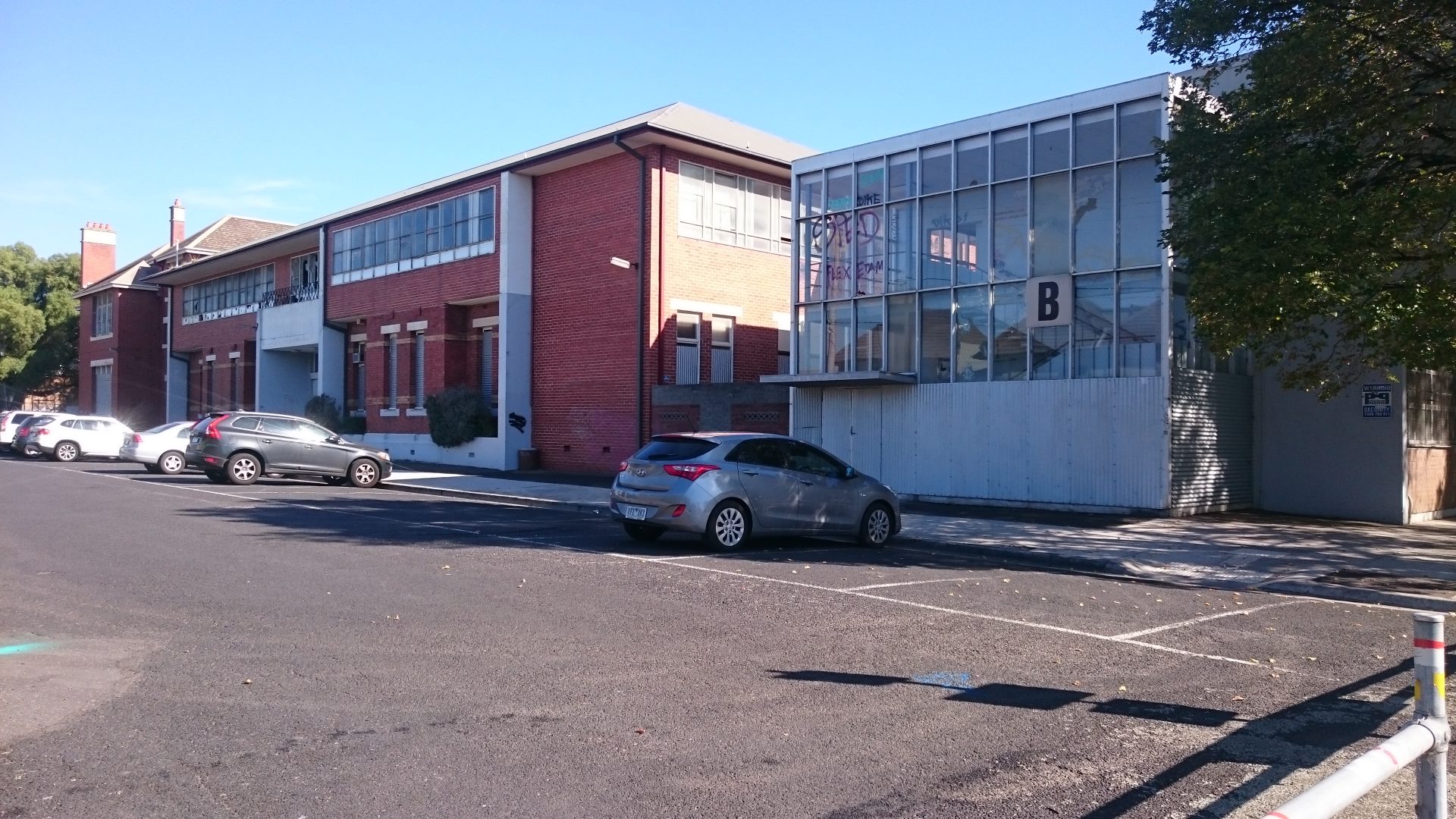 Former Moreland High School
Former Moreland High SchoolMoreland High School opened as Moreland Central School in 1947 on The Avenue, Coburg. It became a High School in 1953 and in the years that followed the original red brick building was augmented with grim Soviet style extensions.
It closed its doors in 1991 and was acquired by Kangan Batman TAFE (now Kangan Institute). The Moreland campus offered courses in community services, health, language studies and business. Then in 2011 the Kangan Institute closed the Moreland campus and relocated to more suitable, purpose-built facilities at Docklands. It has remained boarded up ever since.
Kangan Institute sought to sell the site and in 2014 approached Moreland City Council to have the land rezoned. The red brick building is protected by a heritage overlay, and Council rejected the application. In 2015 the property title reverted to the Education Department, and it is noteworthy that the site does not appear on the Department’s surplus land list.
Is the Education Department letting the ghost school lie fallow, as it did with Preston Girls High School? If so, then it’s further evidence of improved planning, and the expensive debacles seen in Prahran, Richmond and Coburg may be avoided. Are they Learning from the Past? [as at 2020]
What have we learned from the past? Let’s see now:
- Developers would love to acquire such a large site if it went to market. But it should be retained to help address the looming shortage of schools in the fast-growing inner north. Sell-off enthusiasts should catch the Route 19 tram up to Bell Street and spend some time at the old Coburg High School site. Never again.
- The heritage overlay would apply to the original red-brick building, and not the later Soviet style concrete additions. This means that the latter could be demolished to make way for invaluable public open space, while the heritage building could be used as a community facility.
- Moreland City Council should seek to elevate the heritage status of the red-brick schools in the district by applying to the Victorian Heritage Register (VHR). Heritage overlays offer zoning protection, but full registration ensures that historical plaques will be added.
- North Melbourne
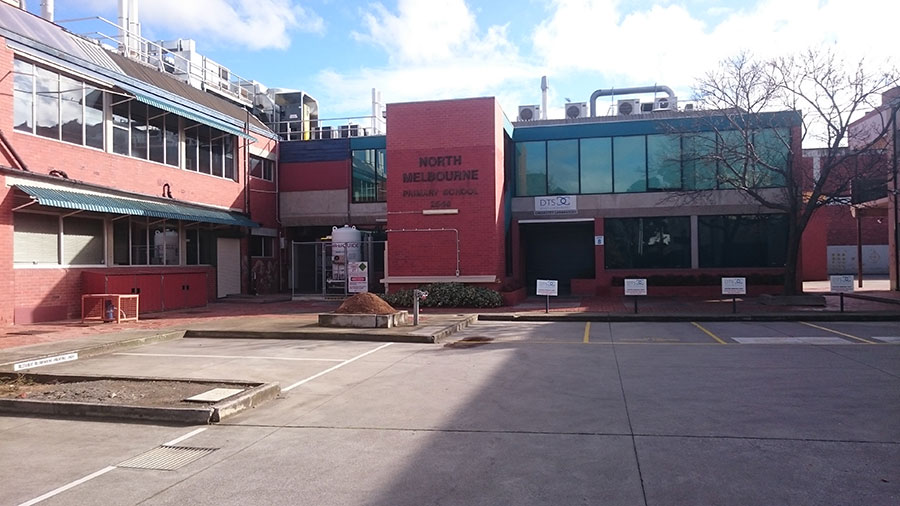 Former North Melbourne Primary School
Former North Melbourne Primary SchoolIn 1990 there were three primary schools in North Melbourne, but now there’s only one. The surviving school, in Errol Street, is experiencing a massive surge in enrolments, thanks to the resumption of population growth fuelled by a development boom.
Today, North Melbourne Primary has nearly 850 students, and is forecast to reach 2,166 in 2031. Corridors have been turned into makeshift classrooms and children are forced to sit on the floor. And while relocatable buildings have been installed, this is a band aid solution to a systemic problem. It’s also a solution that consumes the playgrounds so desperately needed by growing bodies.
So, what happened to the other primary schools? The buildings are still standing, but they’re no longer child friendly. West Melbourne Primary was acquired by the Salvation Army and became its Flagstaff Crisis Accommodation centre. And the Boundary Road School is now an industrial site, although visitors may be confused by the retention of the “North Melbourne Primary School 2566” signage.
History footnote: Boundary Road was originally an 1883 red brick classic, but was demolished by the Education Department in the 1970s and replaced by a ‘modern’ structure. There was no heritage legislation to protect it at the time.
Back in Errol Street, families want more than a relocatable future, and an October 2016 announcement from the Victorian Government indicated that they had at least been heard. The School Provision Review of the Docklands Area called for a Docklands primary school as well as a second primary school in North Melbourne. Albeit the language was peculiar: whether many people view education in terms of ‘market shares’ is questionable.
Planning for the proposed Docklands Primary School is well advanced, if you ignore the fact that land still needs to be acquired. The proposed North Melbourne Hill primary school also involves land acquisition, and even though a site has been identified, there are some planning issues to be resolved. An existing public housing estate on Abbotsford Street is to be rebuilt, and will incorporate a new education facility. The overcrowded North Melbourne Primary wants to use the new site for expansion, or will it be a new school altogether?
To recap: two new schools have been promised to take the pressure off North Melbourne Primary. Land either needs to be purchased or is not yet available. A few more years of corridor squeeze in Errol Street awaits.
Yet a second North Melbourne primary school is staring us in the face, for in Queensberry Street sits the former Hotham State School (no. 307). This 1882 red-brick classic was closed in 1935 and used for a variety of purposes thereafter. In 2009 it became the Bastow Institute of Educational Leadership, an Education Department body. How ironic. Well here’s a chance for the Department to show some educational leadership: move the Bastow Institute and re-establish a primary school on the site.
What have we learned from the past? Try this:
- Don’t rely on consultants. Staff up the Education Department with suitable proactive planning skills, so that ‘surprise’ school census figures are kept to a minimum. The skills are available: just ask the Our Children Our Schools alliance.
- The High School for Coburg campaign was resisted for years, with the government of the day insisting that parents use distant (renamed) secondary schools instead. Reason eventually prevailed, and the new Coburg High School is nearly full.
- The Bastow Institute could be moved, thereby freeing up an ideal site for a desperately needed second primary school in the North Melbourne area.
- Prahran
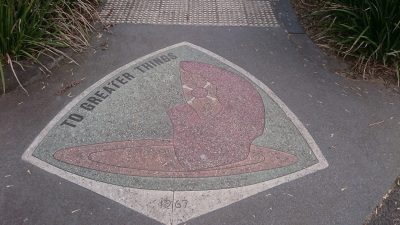 Former Prahran HS shield
Former Prahran HS shieldUpon approaching Orrong Romanis Reserve in Orrong Road, Prahran, you may notice a curious shield in the pavement. What does ‘TO GREATER THINGS… 1967’ mean? The playing fields suggest an answer, but you’d be wrong. For this is where Prahran High School once stood. Demolished after its closure in 1996, the concrete shield is all that remains. At least the site was converted to public open space, a rarity in the inner suburbs.
So, Prahran was without a secondary school when urban renewal saw the children come back. They filled the few remaining primary schools and by 2010 it was clear that a planning debacle had occurred in the 1990s. Politicians of all flavours started looking for available land to build a new school, in an area where land values had skyrocketed.
A bizarre solution was announced in 2014, when the Napthine Government earmarked $20 million to build a new school through co-location with the Victorian College for the Deaf on St Kilda Road. This plan didn’t last long: once neighbouring Wesley College purchased a fraction of the site for $19 million, the new Andrews Government abandoned the co-location idea altogether.
But the 2014 proposal was problematic on other grounds. In particular, the likely negative impact on deaf students if a secondary school was co-located. Despite all good intentions, children with special needs would be swamped by the large and growing secondary school population. This happens. Ask parents of ASD children about special needs support in Victorian Government schools, and they’ll tell you it’s almost unobtainable. The Victorian College for the Deaf made the right call, as did the Andrews Government.
In 2015 a new solution emerged, to convert the former Swinburne University site on High Street into a High School. Although an enrolment capacity of only 650 seems surprisingly low, the new Prahran High School opened as planned in 2019. TO GREATER THINGS? We hope so.
What have we learned from the past? Let’s see:
- Governments must expect that land values in the inner suburbs will continue to increase at a dramatic rate. Any school site sales are likely to prove economically unsound in the long run.
- Government schools should be built where they are needed without compromising the education of children with special needs.
- The conversion of a former school site to public open space clearly benefits the local community. However, treating it as a temporary measure could be problematic. Reclaiming the land to build a school may yield a public outcry that kills the idea.
- Preston
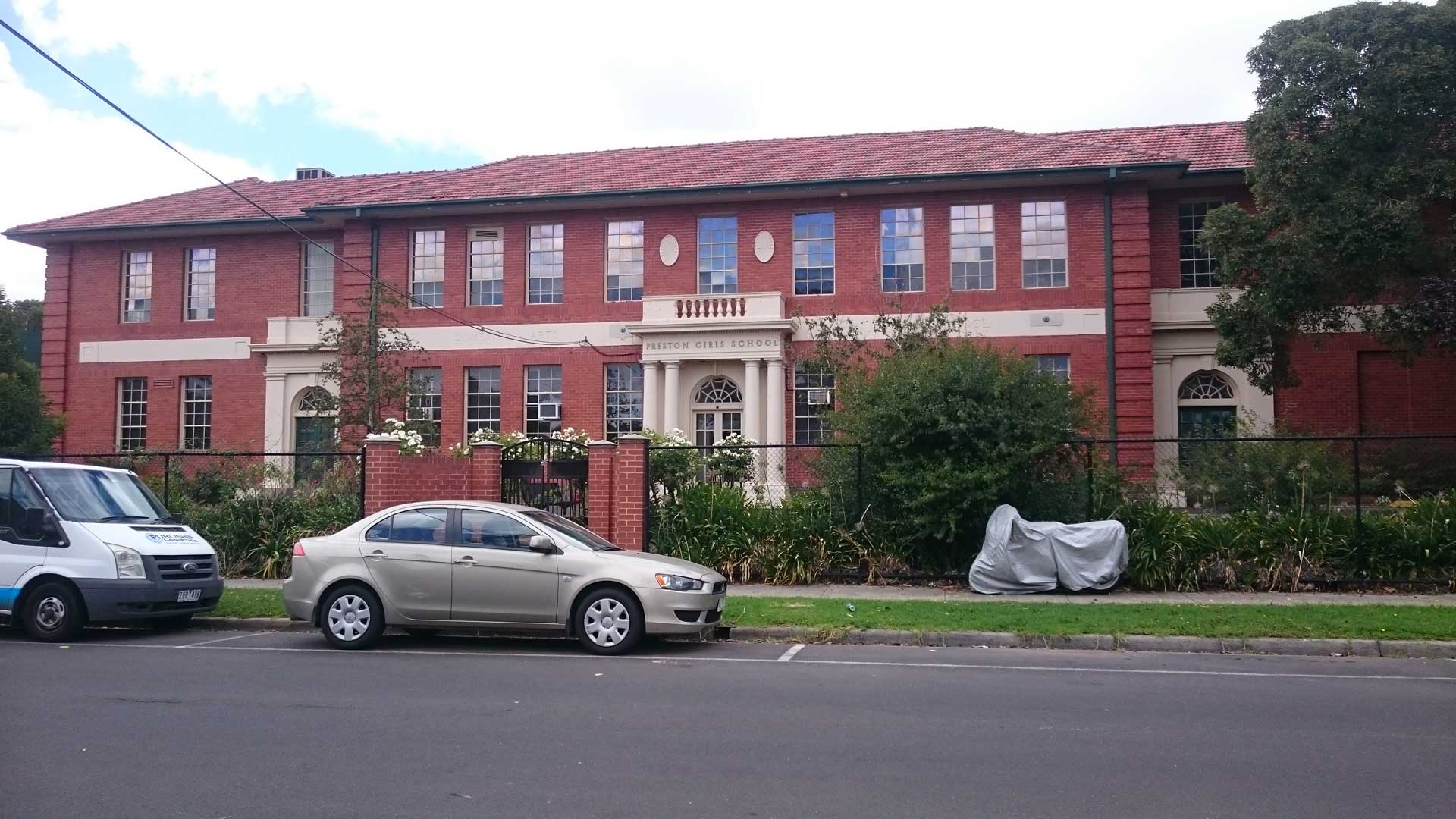 Former Preston Girls High School
Former Preston Girls High SchoolPreston Girls High School opened in 1928 in Cooma Street, Preston. The original red-brick building and additions are surrounded by ample playing fields. It closed in 2013 citing unsustainably low enrolments, but the booming enrolments in the local primary schools told another story. Clearly, a coeducational secondary school would be required in Preston within a few years.
Fortunately, the Education Department appeared to have learnt something from the High School for Coburg campaign. In June 2014, the Department announced that the former school would be retained in order to be relaunched as a co-educational secondary school sometime in the future. The recently formed High School for Preston campaign was delighted with the news, coming only a month after the State Budget finally provided funds for building the future Coburg High School. In an election year it appeared that inner suburban government schools had finally achieved pork-barrel status.
Long written off as Labor Party strongholds, the gentrification of the inner suburbs has changed the electoral map. Many seats are now marginal, with The Greens, Labor and the Coalition engaged in a fascinating tussle for control. Government schools are now a hot topic, and it’s about time.
In November 2016 the Education Minister announced that it would indeed be reopened as a co-educational high school. The new Preston High School opened on target in 2019. This well-conceived project will cost markedly less than other inner suburban school building projects, thanks to the retention of a valuable public asset for future use.
What have we learned from the past? Let’s see:
- Timing is everything. Preston Girls High School closed just as the primary schools in the area were running out of room. This made it easier for demographers to avoid the mistakes of the 1990s and allowed the Education Department to let the former school ‘lie fallow’ for several years.
- How long should a public building remain unused, and does it matter? A full range of community options should be canvassed.
- Councils should ensure that district schools are considered for heritage overlays on an ongoing basis. Consistency among councils is to be encouraged.
- Richmond
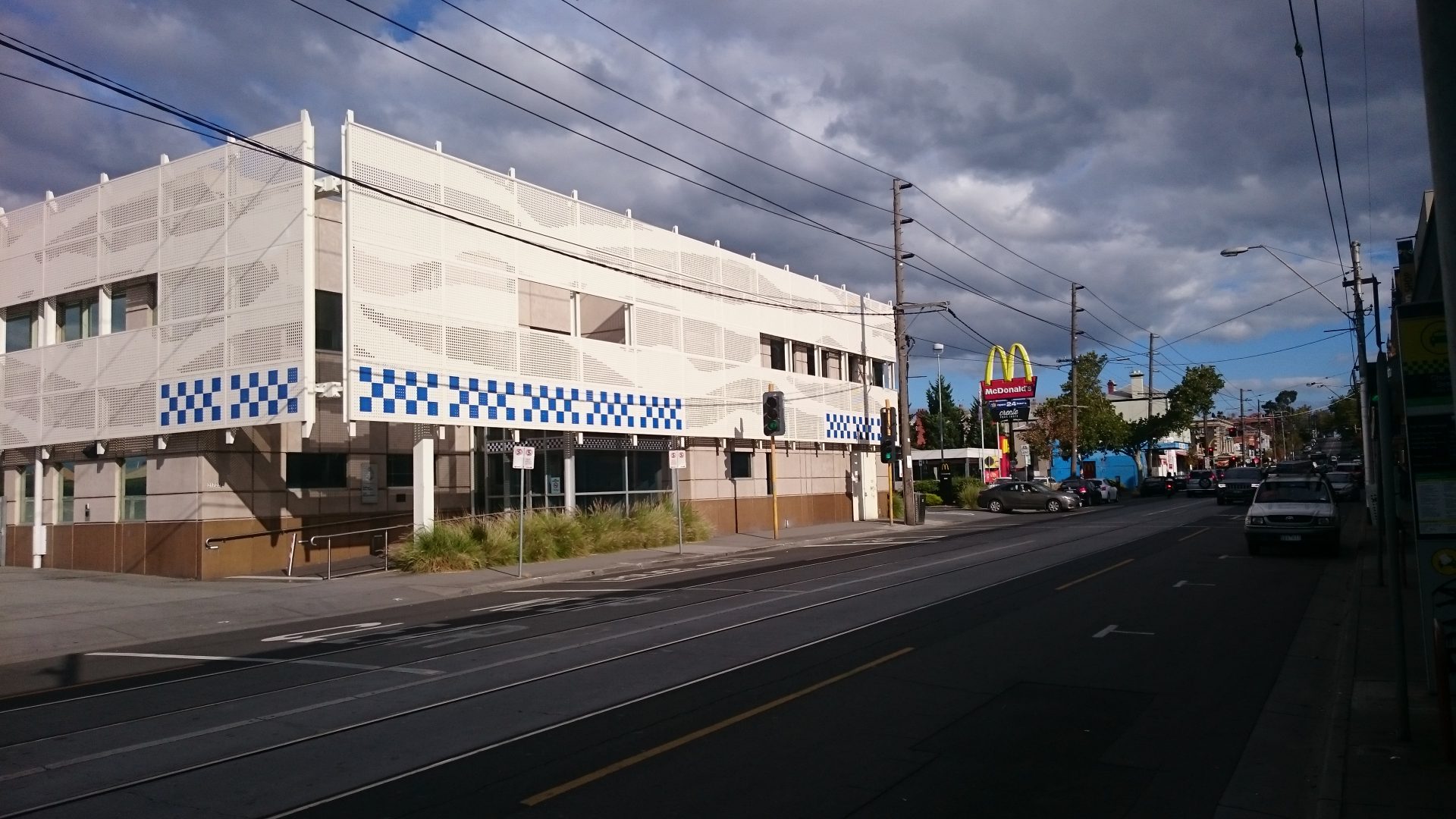 Richmond Technical School was here
Richmond Technical School was hereRichmond used to have three secondary schools. Richmond Technical School and Richmond Girls High School were both located behind the Town Hall, while the coeducational Richmond High School was on Yarra Boulevard. All three were closed in the early 1990s, and each had a different fate. Richmond Girls is now Lynall Hall Community School; Richmond Technical School is now a police station and a McDonald’s restaurant, while the Richmond High School site is now occupied by Melbourne Girls’ College.
There was an obvious problem: boys did not have a secondary school in Richmond for over 20 years. And by the new century there were a lot more of them too (and girls).
The Richmond High School Choices campaign was launched in 2006, but it took until 2014 for the issue to gain traction. The opposition Labor Party went to the election promising that Richmond would get a new coeducational High School. But even after gaining office, the realities of opening new schools in the inner suburbs always involves a major hurdle: how to find sufficient land when competing with cashed-up developers.
In 2015 the State Government announced that land had been identified in Gleadall Street, close to where Richmond Technical School once stood. Then additional land became available on nearby Griffith Street, being a site that once housed Richmond Central School (closed 1987). Together, they were to form the dual campus Richmond High School. The Gleadall Street campus opened for the 2018 school year, and the Griffith Street campus in 2019.
While the opening of a new coeducational High School in 2018 was good news for the people of Richmond, we note that it doubles as a community facility. The same applies to the new South Melbourne Primary in Ferrars Street, and can be expected to become a consistent feature of future school design. But we can’t help wondering how schools with broad community access will be able to comply with the Child Safe Standards.
What have we learned from the past? Let’s see:
- Boys need secondary schools. It’s a legal requirement until they are 16. So, governments must provide local schools for both genders.
- Inner city schools have finally become a political issue. Irate parents are becoming aware of this and the political parties will no longer be able to assuage them with platitudes.
- The Child Safety Standards are aimed at managing the risk of child abuse in schools. New school design that incorporates broad community use of the same facilities will necessitate more stringent security monitoring. The associated costs and privacy considerations will need to be factored in to project planning.
- South Melbourne
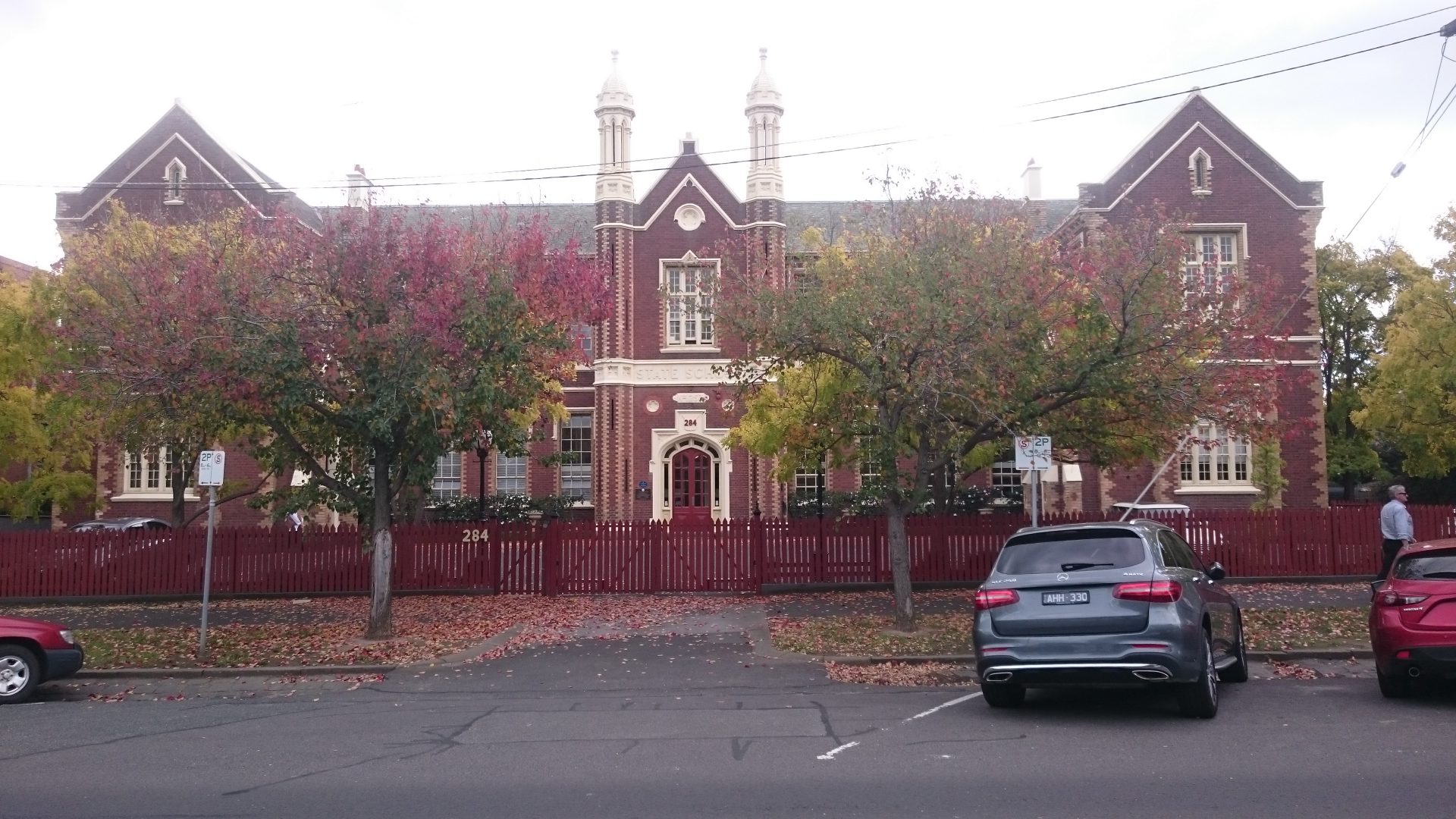 Former Dorcas Street Primary School
Former Dorcas Street Primary SchoolWhat a conundrum: you couldn’t send your children to a government primary school in South Melbourne, but you could live in one instead. Both the Eastern Road (Emerald Hill) and Dorcas Street primary schools were closed in the 1990s, but their heritage status saved the buildings themselves. The Dorcas Street school is particularly striking: a Charles Webb design, it opened in 1881 and closed in 1996. Even though it has been converted to prestige apartments, the Victorian Heritage Register plaque out front acknowledges its proud history.
For several years the Two Schools Now campaign pushed for new schools in the inner south, where the population explosion had exposed the folly of planning decisions made 20 years ago. In 2014 the Victorian Government acknowledged their concerns by purchasing land in Ferrars Street for a new primary school.
The new South Melbourne Primary School opened in 2018 on a site measuring little more than 5,000 square metres. That’s tiny by Australian school standards, and so Victoria’s first vertical school resulted. That means five-year olds in a five-storey building! And as for the childhood obesity epidemic, there’s not much public open space at the industrial end of Ferrars Street.
There’ll be more vertical schools to come in the inner suburbs, because available land is in such short supply. Still, it’s galling to note that we’ve been reduced to this, thanks to some poor planning decisions in the 1990s. And it’s sad to reflect that the former Dorcas Street Primary School is only 400 metres away.
At least there’s more to come. South Melbourne Park Primary School opened in 2019, and it is not a vertical school. A creative mix of historic and new buildings located in Albert Park Reserve, there is ample open space available. However, we should note that the former Eastern Road Primary School is only 800 metres away.
What have we learned from the past? Let’s see:
- Being on the Victorian Heritage Register (VHR) saved the former South Melbourne primary schools from the wrecking ball. More fine old schools should acquire that heritage status.
- Although the VHR provides for a formal plaque to be placed on a building, the information included is mostly architectural. In the case of schools, the plaque should be augmented with information about the people who attended over the years.
- If vertical schools are to become a feature of education in Victoria, then land acquisitions need to be carefully considered to optimise open space options. Particularly for primary schools.

